Table of contents: 2012 articles
These are the columns published in the fifth year of Offbeat Oregon History.
<< Oldest | < Older: 2011 stories | | — This page: 2012 stories — | | Newer: 2013 stories > | Newest >>
No. |
Date: |
Headline |
Thumbnail |
Area |
215 |
12/30/12 |
Larry Sullivan: Boxer, politician, con artist, shanghai manA prizefighter with a great head for business, friends in high places and absolutely no conscience, Larry Sullivan organized Portland's shanghaiiers into a cartel — causing international notoriety for Portland. (Part 1 of 2) |
 |
•Portland |
214 |
12/23/12 |
Chemawa School: An Oregon cultural treasureCreated to stifle Indian culture, the oldest surviving Native American boarding school has done the opposite — and it's fortunate for Oregon's cultural heritage that it has. |
 |
•Salem |
213 |
12/16/12 |
Jim Turk: Shanghaiier, swindler, drunkard, millionaireThe old Portland shanghai scene's 'original gangster' was a mysterious character. Did he really inherit $30,000? If not, where did the money come from? |
 |
•Portland |
212 |
12/09/12 |
Visit to Portland ended with life in prisonLike the hero of an 1800s "cautionary tale," teenager Joseph Swards stepped off the ship, fell in with bad company, got caught up in a robbery that went horribly wrong — and in the end was lucky he wasn't hanged. |
 |
•Portland |
211 |
12/02/12 |
The fall of the Prineville VigilantesCrook County citizens finally decided they'd had enough of the secretive lynchings and killings, and they banded together and defeated the gang of masked riders without a single shot being fired. (Part 2 of 2) |
 |
•Prineville area (Crook County) |
210 |
11/25/12 |
When the Vigilantes ruled PrinevilleIn Crook County, the early 1880s were like something out of a Louis L'Amour novel: Masked riders galloping around by night, dispensing what they saw as justice. It all started with the lynching of an innocent man. (Part 1 of 2) |
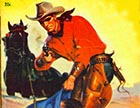 |
•Prineville area (Crook County) |
209 |
11/18/12 |
Horrifying asylum kitchen mix-up left dozens deadSent downstairs to fetch a pan of powdered milk, a kitchen assistant at the Oregon State Hospital dipped his scoop into the wrong bin — and brought back six pounds of roach poison. It was mixed into the eggs and fed to 467 people. |
 |
•Salem |
208 |
11/11/12 |
Courthouse square once was the site of palatial “Hotel Portland”The grand monument to the Gilded Age was a municipal architectural treasure and hosted U.S. presidents, but was razed in the 1950s to make way for a parking garage; all that remains is a wrought-iron rail. |
 |
•Portland |
207 |
11/4/12 |
Boozy generosity turned the tables for the Prineville Nine that dayWall Street financial wizard Thomas Lawson happened to be in town and betting on Prineville's amateur baseball team, when he learned the Silver Lake team had hired "ringers" to make sure they'd win. It was working; they were up 9-0 halfway through. But Lawson knew how to change that. |
 |
•Prineville |
206 |
10/28/12 |
Senator John H. Mitchell: The Snidely Whiplash of OregonJohn Hipple dumped his family, changed his name and moved West. A dozen years and a few easy-money real-estate swindles later, he was a wealthy man, a prominent Portland citizen, a hugely successful railroad-and-timber lawyer and a U.S. Senator. |
 |
•Portland |
205 |
10/21/12 |
Long-lost Guild's Lake was once Portland's water wonderlandThe hordes of awestruck visitors who admired the scenery at the 1905 Lewis and Clark Exposition would have been shocked if they'd known the beautiful little lake would be gone in 20 years — filled in for industrial lands. Not a trace remains. |
 |
•Portland |
204 |
10/14/12 |
Mysterious skeletons of Oregon: If only these bones could speak ...Sometimes the silent bones of the long dead almost seem to want to tell their stories ... but, of course, they can't.There are a few stories of skeletal remains found in Oregon whose secrets will probably never be known. |
 |
•Scio, Prineville, southeastern high desert |
203 |
10/07/12 |
Deadly weather catches Oregon by surprise when it comesCyclones, tornadoes, flash floods, earthquakes and volcanoes — the Beaver State is not immune to any of these things, but they're rare enough that no one is expecting them when they appear. |
 |
•Astoria, Heppner, Aumsville, Portland, etc. |
202 |
9/30/12 |
Auburn: A long-gone gold town's short but colorful pastThis was the town where the Eastern Oregon Gold Rush of '61 got started, and it was a wild and lawless place; town ordinances did prohibit stabbing or shooting people “in public places," but otherwise the town was mostly wide open. |
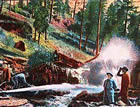 |
•Near Baker City |
201 |
9/23/12 |
Buck Rogers-style police boat didn't work out for PortlandProlific Portland inventor Victor Strode designed a boat that was half airplane and all art-deco-age futurism, and early tests with a smaller model were very promising. But the larger model he built for the city was a disappointment. |
 |
•Tomahawk Island, Salem, Portland |
200 |
9/16/12 |
Oregon's most famous elephant led a colorful and tragic lifeLargest elephant in captivity went from 'Tusko the Magnificent,' star of Lotus Isle, to 'Tusko the Unwanted,' abandoned at the Oregon State Fair, with several destructive rampages along the way. |
 |
•Tomahawk Island, Salem, Portland |
199 |
9/09/12 |
The story of Lotus Isle, Oregon's most surreal amusement parkThe short-lived attraction on Tomahawk Island was launched in an attempt to shake down the owners of nearby Jantzen Beach; their bluff called, the backers were forced to go forward with it |
 |
•Tomahawk Island (Portland) |
198 |
9/02/12 |
Fort Rock's legendary Reub Long could spin a wild “tall tale”Oregon was once known as a place full of "great liars" — tellers of tales so tall they'd cause every pair of pants in the room to spontaneously burst into flame. Oregon storyteller Reub Long could hold his own with the best of them. |
 |
•Fort Rock, Bend |
197 |
8/26/12 |
Schemers sought to seize Peter Iredale shipwreck, sell for scrapClackamas County man claimed his father had bought the salvage rights in 1908, setting off a huge dust-up among residents, beachgoers and politicians, who scrambled to protect the landmark wreck. He almost got away with it, too. |
 |
•Astoria, Warrenton |
196 |
8/19/12 |
Apollo 15 astronaut left a piece of Oregon lava on the moonWhen astronaut Jim Irwin came to Bend for lunar landing training in the lava rock of Oregon's 'moon country,' he made friends with a local resident — who gave him a sliver of Oregon lava to leave on the moon's surface. And so he did. |
 |
•Bend, McKenzie Pass, the moon |
195 |
8/12/12 |
Before newspaper “crusade,” tainted milk was killing babiesState regulators didn't care, so neither did some dairy farmers, who left dead cows to rot among their dairy herds and brought milk to market in the same cans they used to slop the hogs; Portland led the nation in baby deaths as a result. |
 |
•Portland |
194 |
8/05/12 |
Long-gone dance hall hosted Chuck Berry, Johnny Cash, moreElvis Presley himself is rumored to have played at The Cottonwoods, a jumpin' joint near Lebanon, where thousands danced to the music of many of the 20th Century's greatest musicians. Today, it's a vacant lot — piled high with memories. |
 |
•Lebanon/ Albany |
193 |
7/29/12 |
Rusty derelict turned out to be historic Liberty Ship lifeboatWhat looked like a rotting-away hunk of scrap steel was a rare artifact of Portland's World War II shipbuilding industry — but the discovery was made just a few days too late. |
 |
•Sauvie Island |
192 |
7/22/12 |
Busting out of the joint was a job for a safecracker, 100 years agoOf all the prisoners who tried to escape from Oregon's state prison, the "yeggs" were most successful — if “successful” is the right word. Their schemes for leaving the jailhouse behind included a tunneling scheme right out of “Shawshank.” |
 |
•Salem |
191 |
7/15/12 |
Prison break happened during “conjugal visit” at cheap motelBy far the most embarrassing jailbreak in state history happened when a murderer simply walked out the back door of a Motel 6 during an unsupervised “date” with a woman officials thought was his fiancee. |
 |
•Salem |
190 |
3/11/09 |
The heroic final flight of Cottage Grove's Jim WrightHe'd spent thousands of hours re-creating history's most mysterious aircraft. Something had gone wrong, and he was about to crash it. When he did, somebody would die — who that would be was up to him. |
 |
•Cottage Grove |
189 |
7/08/12 |
Quest for “Lost Cabin Gold Mine” led to discovery of Crater LakeMiners were searching for a fabulous source of gold, formerly belonging to a friend who'd mysteriously disappeared; they never found it, and maybe it's still out there somewhere. |
 |
•Jacksonville, Crater Lake |
188 |
7/01/12 |
Crooked gambler and liquor man was Portland's first police chiefJames Lappeus came to Portland from the gold fields of California, where he was a gambler, saloonkeeper and general mining-town rowdy. His career as a cop was dogged by rumors he'd offered to spring a murderer for a $1,000 bribe. |
 |
•Astoria |
187 |
6/24/12 |
In 1880s, salmon were the real “most dangerous catch”Fishermen working in heavy 24-foot boats at the mouth of the Columbia kept getting sucked out onto the bar and drowning in its massive breakers. Their odds of not surviving a season were as high as 1 in 15. |
 |
•Astoria |
186 |
6/17/12 |
Oregon lost world's biggest log cabin in spectacular 1964 fireAncient electrical wiring ignited Portland's legendary Forestry Building, a structure made of massive, flawless old-growth logs that had been built for the Lewis and Clark Exposition in 1905. |
 |
•Portland |
185 |
6/10/12 |
The mysterious demise of the S.S. South Coast: What happened?Historic steam schooner vanished on a calm night in 1930, leaving lifeboats and debris floating in the water — but no bodies, alive or dead. Was it a violent micro-storm? A “seaquake”? A boiler explosion? We'll never really know. |
 |
•Coos Bay |
184 |
6/03/12 |
How Oregon almost lost public access to its beachesAfter a beachfront landowner discovered a loophole in the law and fenced off “his” beach, other oceanfront property owners were eager to follow suit. Governor Tom McCall was determined to stop them, and this is how he did it. |
 |
•Cannon Beach |
183 |
5/27/12 |
Oregon's first female lawyer: A legal Mother Teresa?The real Mary Leonard was probably someone who had given up “the good life” after realizing, during her time in jail, that the powerless women of her time were getting a raw deal — and determined to do something about it. |
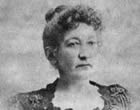 |
•Portland |
182 |
5/20/12 |
Pioneering Oregon “lady lawyer” deserved a better legacyHad Mary Leonard died in 1890, she'd be remembered as a brilliant orator and an inspiration to future Oregon women and attorneys. But fate let her live another 20 years, during which she devolved into a total nut case. |
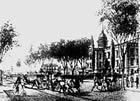 |
•Portland |
181 |
5/13/12 |
Oregon's first female lawyer faced trial for murder of her husbandHistorians, eager to see in her the caricature of the nagging, garrulous fishwife and gold-digging black widow, have missed the real story of Mary Leonard — and done both her, and the historical record, a disservice. |
 |
•The Dalles, Portland |
180 |
5/06/12 |
“Roaring Twenties” murder mystery solved by cop's diligenceCaught by a railroad “bull,” the thief shot his way out and ran for it. But an accurate shot by the dying guard and some persistent police work brought the bad guy to justice in a pistol-waving scene in a seedy Albina hotel room. |
 |
•Albina (Portland) |
179 |
4/29/12 |
Giant skeleton find recalled old legend of pirate treasureNeighbors wonder if the eight-foot-tall skeleton found by developer at what today is YWCA Camp Westwind was evidence that an old Native American legend of a pirate ship is true; if so, there might actually be booty buried there, some say. |
 |
•North Lincoln County |
178 |
4/22/12 |
Historic mansion was once home of Portland “starvation cult”The motto of Kate Ann Williams' cult was "Pray and be Cured," and adherents went on rigorous 40-day fasts that occasionally killed them. The cult disappeared after its leader starved herself to death. |
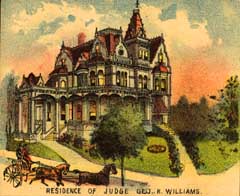 |
•Portland |
177 |
4/15/12 |
Oregon man's Supreme Court confirmation scotched by his wifeSenate committee went from a solid consensus to confirm George H. Williams, to a firm determination not to, in just one week. The cause? Most believed it was because of the arrogant attitude of Mrs. Williams toward the senators' wives. |
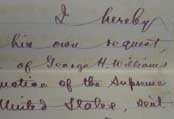 |
•Salem, |
176 |
4/08/12 |
Mass murderer honored in monument at county courthouse75 years ago, without realizing who he was, Wallowa County included Bruce “Blue” Evans — leader of the gang that massacred dozens of innocent Chinese miners back in 1887 — on a plaque commemorating its pioneers. |
 |
•Snake River/ Wallowa County |
175 |
4/01/12 |
Mariner survived shipwreck by being trapped in the wreckageGeorge May was in an impossible situation, trapped in the upside-down hull of his ship, waiting for death. But then the ship washed ashore, the tide receded, and he lived to tell the story of the wreck of the M/V Oshkosh. |
 |
•Oregon Coast |
174 |
3/25/12 |
Shanghaied in Astoria: Port city was once a perilous placeDesperate for men, shanghai operators once tried to kidnap the local Methodist minister — but it turned out he was not the soft, defenseless target they'd thought he'd be. |
 |
•Astoria |
173 |
3/18/12 |
“Oregon’s Outback” was a real moonshiner's paradise in ’20sCentral and Eastern Oregon was “Oregon's liquor cabinet” during Prohibition; its wide open spaces and tight-knit communities made busting bootleggers uncommonly difficult there. |
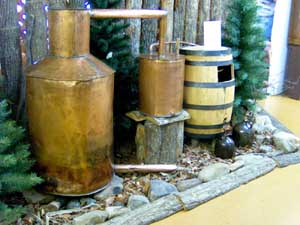 |
•Prineville area, Central Oregon |
172 |
3/11/12 |
Postwar Portland turned away Nat “King” Cole, Billie HolidayCrusty, spluttering city leaders, full of self-righteous outrage over mixed-race dancing that was going on at “The Dude Ranch,” found an excuse to order the West Coast's hottest jazz club shut down. |
 |
•North Portland |
171 |
3/04/12 |
Cruise-ship skipper wasn’t the first to “fall into a lifeboat”Captains are supposed to be the last to leave their sinking ships, not the first. But that required act of valor has always been easier said than done — as evidenced by the story of the 1903 wreck of the S.S. South Portland off Cape Blanco. |
 |
•Cape Blanco |
170 |
2/25/12 |
Incompetent opium smugglers had friend in high placesPolitical boss James Lotan had landed a federal appointment that was flush with possibilities for graft and corruption. Too bad he picked such a bumbling group of criminals to partner up with. |
 |
•Portland |
169 |
2/19/12 |
First seaworthy log raft helped Oregon build city of San DiegoLumber magnate Simon Benson needed to get logs from the Columbia to his mill in Southern California, so he designed cigar-shaped log rafts a full acre in size. They were a familiar sight until the early 1940s. |
 |
•Clatskanie/ Lower Columbia River |
168 |
2/12/12 |
Fog made the difference between a reprimand and a medalLegendary Coast Guard lifesaver took his brand-new rescue boat dangerously close to shore to save four drowning people; hundreds of people were watching and cheering, but USCG brass wanted to bust him for risking the boat |
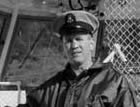 |
•Newport/ Yaquina Bay |
167 |
2/05/12 |
Homesteader’s plan to get extra land involved bigamy, murderNorman Williams “married” her to get title to her land claim, but then she found out he had another wife in Dufur, so she moved out. So he killed her and her mother and forged her signature on the land-claim deed. |
 |
•Hood River |
166 |
1/29/12 |
Forty-day debauch made Oregon legislature nationally notoriousSix-week-long drunken party was thrown by the notoriously rascally Jonathan Bourne Jr. to keep the state Legislature from convening, so it couldn't elect John H. Mitchell to the U.S. Senate. It worked — well, sort of. |
 |
•Salem |
165 |
1/22/12 |
Coast Guard catastrophe sprang from bad boat designBafflingly, the Coast Guard's biggest rescue boat on the Columbia River Bar was one that hadn't been designed to survive a rollover. So, in early 1961, it didn't — and neither did five members of its six-man crew. |
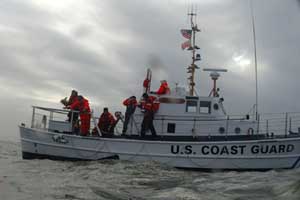 |
•Columbia River bar |
164 |
1/15/12 |
Coast Guard's worst Columbia disaster started as routine rescueMammoth seas on the legendary Columbia River Bar, plus the untimely removal of a vital piece of life-saving gear by short-sighted military brass, cost the lives of five Coast Guardsmen that night. |
 |
•Columbia River bar |
163 |
1/08/12 |
Tangent City Hall office cat was the city's landlordWillamette Valley town's mascot was the state's wealthiest housecat; he owned City Hall along with the farm it was built on, as well as an iconic red barn. Today, you can visit Kitty Kat's grave, but his barn is in danger of being torn down. |
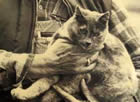 |
•Tangent |
162 |
1/01/12 |
Oregon City was home of world's first electric power gridEntrepreneurs figured out how to send power long-distance for the first time in American history; later, after a flood wiped out power station, they pioneered alternating-current transmission |
 |
•Oregon City |
<< Oldest | < Older: 2008-2009 stories | | — This page: 2010 stories — | | Newer: 2011 stories > | Newest >>

